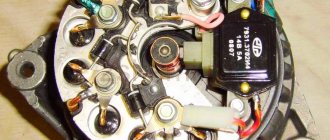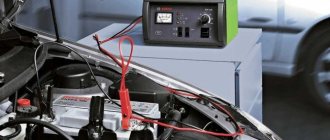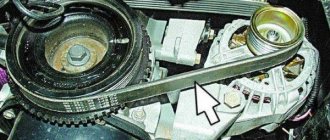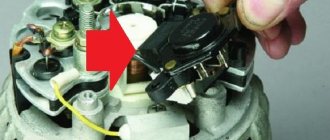Possible reasons
On-board voltage on the VAZ 2114 is provided by two energy sources: a generator and a battery.
Working in tandem, they supply the necessary energy to all consumers in the car. The operation of such a miniature electric bus station must be stable and produce approximately 14 V. At full load, a drop of 1 V is allowed, no more. If other indicators are displayed, it may indicate a malfunction.
Let us indicate all the possible reasons for the low voltage of the on-board network on the VAZ 2114:
- Mechanical problems with the generator.
- Installation of additional devices in the car that take electricity (car refrigerator, subwoofer, etc.).
- Incorrectly installed consumers on the network. Even a homemade connected radio can cause a decrease in voltage.
- Poor quality wiring and electrical circuit malfunctions.
When trying to solve a problem with electrical wiring and consumers, it is important to take into account the factory parameters of the vehicle’s electrical network. Otherwise, you will have to spend money on expensive repairs from service station specialists.
Mechanical problems include:
- destruction of the mounting bracket;
- weakening or complete breakage of the drive belt;
- generator bearing wear.
Electrical circuit problems are much more difficult to detect than mechanical problems. You cannot do without special devices, unless you can see a burnt-out terminal or drive.
The most common causes of electrical circuit breakdowns include:
- breakdown of the diode bridge;
- short circuit in the stator winding of the electric motor;
- malfunction in the brush assembly;
- lack of current on the excitation winding;
- violation of the geometry of the slip rings (most often they become clogged with graphite dust);
- rotor runout.
A malfunction in the brush assembly is determined by wear or complete destruction of the brushes.
Wires, non-original connections, low-quality devices
The issue of poor-quality connection of on-board network consumers is worth considering in more detail. If you installed the radio in your car yourself, taking power from the wrong place, the problem of battery drain and load on all vital organs will be very relevant. It is better to exclude handicraft interference in the electrical power system altogether. If something needs to be delivered, contact the station and do it efficiently. The following problems of increased load on the system are possible:
- one of the consumers draws all the voltage, reducing it in the network to incredible levels, this could be a subwoofer or powerful speakers that are not provided in the car;
- you additionally installed powerful equipment and connected it through the cigarette lighter and other elements of the electrical network that are not intended for this;
- low-quality wires were used in the connection, also the problem with the wires may be present in the car from the factory, this can only be eliminated by replacing the wiring with a more expensive one;
- a failure in one of the important elements of the electrical network, the presence of increased electricity consumption and a significant drain on the machine’s resources, which negatively affects the network;
- problems with incorrectly installed relays and fuses that interfere with the normal functioning of the car’s organs, but this can only be determined after professional diagnostics.
Troubleshooting yourself
It’s wise to start car repairs by looking for the simplest faults, in our case mechanical damage. You should inspect the drive belt, adjust its tension, and rule out a malfunction of its brush mechanism. You can tighten the fastenings of the power wires. If this work does not bring results and the on-board network voltage on the VAZ 2114 is still low, then you can begin to disassemble the entire assembly and carry out a full diagnosis of it.
The stages of work, as in the first case, should preferably be carried out from simple to complex:
- Check the regulator to see if it is in working condition.
- Check the voltage on a cold motor, it should be no less than 14.5 V.
- Turn off the car engine and disconnect the battery terminals.
- It is imperative to disconnect the electrical wiring from the unit to be repaired.
- Carefully remove the protective cover from the electrical contact unit.
- Remove the wiring block and regulator.
- Check the condition of the brushes and brush holder; if they are faulty, replace them with new ones.
- Make sure the regulator (tablet) is working properly. This can be done using a battery, two regular batteries (finger-type batteries) and one 12 V incandescent lamp. To determine the operating status of the regulator, it is necessary to alternately apply voltage of 12 V and 15 V. The lamp on the brushes should be lit.
- If a regulator malfunction is detected, you must buy a new one and replace it.
- Check the diode bridge. Replace the faulty spare part with a new one by removing the generator from the car.
- If you have minimal knowledge of an electrician and armed with a multimeter, check the functionality of all diodes (six power and three additional). To do this, you need to unscrew the nuts securing the spacer bushings, disconnect the wires and remove the horseshoe.
- Check the generator winding. If a breakdown is detected, it must be replaced.
- Disconnect the battery using the following tools: - pry bar; — keys for 13 mm and 10 mm; — 3 socket heads for 13, 17 and 19 mm. First, you should remove the wire that powers the battery, then use a 13 mm socket to unscrew the 2 bolts that secure the adjustment bracket. After this, turning the generator, you can slowly remove its mounting axis to the bracket.
- Be sure to diagnose the performance of the front bearing assembly.
VAZ 2115 problem with voltage surges and constant undercharging
The problem arose when a good battery first depleted to the point of "crackling, clicking starter". I loaded it and forgot about it. Then over the course of a year the problem repeated itself 8 more times - I threw out the battery and bought a new one. They checked it at the store and found that the battery was working, put it in the car and drove off. After some time, the new battery landed at 0. I visited 3 electricians - there was a problem with the generator. I went to the repairmen, they removed the generator, checked it on a stand, disassembled it, rang the circuits - everything is fine, the generator is working properly. Current leakage - 0.03 amperes, 0.02 without security switched on. We measured the voltage at the battery terminals (when running) - 13.9 volts. I personally measured the voltage from the + battery (plus the multimeter to the plus battery) to the generator housing (minus to the generator housing) - the voltage jumps from 13.9 volts to 1 volt, then from 13.9 to 7 volts, from 13.9 to 10 volts, then again to 0. This is the only place where the voltage jumps. So the problem is in the gene? Or where to dig?
How many volts and amperes should the VAZ 2114 generator produce?
The generator of the “fourteenth”, like any other car, is designed to convert the energy produced by the motor into electric current. The electricity it generates powers all the electrical equipment of the car. For normal operation, the generator must have a certain current strength and produce the required voltage.
In this regard, many owners are interested in how many amperes the VAZ 2114 generator produces. If the car has a standard part, then it is designed for 90 A. question of how many volts a generator on a VAZ 2114 should produce is no less than 13-13.2 V. On average, this value is 13.6 V. But this is at full load. When consumers are turned off, it is much higher.
How to check the generator voltage on a VAZ-2114 battery?
The operating condition of the generator on the VAZ-2114 should be checked every 6 months (best before and after winter - approx.), because it is in winter that the electrical network experiences increased loads. The check must be carried out regardless of whether it is working or not.
The importance of checking the generator is high, because if it is not capable of delivering a charge of a certain power, then the battery will simply discharge and the car will not be able to start, and if the voltage is excessively high, then problems can arise directly in the wiring and circuit of the car.
Signs of a generator malfunction
If one or more of the following symptoms appear on your car, then the generator must be checked:
- There is extraneous noise or hum coming from the generator. The noise will indicate that the bearings have failed (in most cases the front one breaks - approx.). You cannot drive with such a breakdown, because its jamming can lead to failure of the entire generator after the destruction of the bearing.
- On the instrument panel, the battery warning light shines too brightly, even when the engine is not running - this will indicate an excess of energy in the network.
The lamp burns brighter than usual.
- The battery light does not light up, the turn signals and other electrical devices do not work - this is because the battery is not receiving energy due to a non-working generator.
What generator is installed on the VAZ 2114?
Having figured out what voltage the generator on the VAZ 2114 should produce, it’s worth understanding what kind of device produces it. This domestic hatchback is equipped with a three-phase generator type 94.3701 . It consists of a stationary winding or stator, a rotor, rotor bearings, an impeller, and a pulley for putting on a belt. It also has a diode bridge or rectifier, a voltage regulator and a housing.
Russian-made devices of the KZATE brand were installed on the car from the factory. Also, on some cars of recent years of production you can find standard German Bosch. Despite the fact that domestic generators, with proper care, can be used for a relatively long time, foreign-made parts are considered more reliable. Therefore, when replacing, many owners buy products from this or another foreign brand. In addition, sometimes more powerful generators are installed. They are purchased, for example, by car audio enthusiasts, since the factory ones are not designed for such a heavy load.
How to measure generator voltage?
Knowing what voltage the generator should produce, you also need to be able to measure it. Otherwise, it will be impossible to understand that it is too low or prohibitively high. There are two ways to measure voltage. The first one is very simple, but imprecise. The car's on-board computer shows the voltage. Therefore, you can simply look at his testimony. Unfortunately, they are often underestimated. Therefore, you should not rely on these data to accurately diagnose the generator. In addition, sometimes the voltage on the on-board computer fluctuates under load. But this is not always a reason to troubleshoot. Perhaps one of the consumers is too powerful or connected incorrectly. Or is it just a device error.
The second method gives the most accurate result. To do this you will need a multimeter and an assistant. The measurement is performed in the following sequence:
Next, you should carry out the same check with the consumers turned off. With a working generator, the voltmeter will show about 14.5-14.7 V.
To diagnose the generator, you need to connect a multimeter to its terminals. The device should display values in the range of 14-14.3 V. Then you should ask an assistant to increase the engine speed. The voltage of a working generator should not jump by more than 0.5 V. If it changes or was initially lower or higher than expected, the unit needs to be repaired.
Diagnostics of the relay regulator
Checking the relay regulator when recharging the battery is not a complicated procedure and you can do it yourself using a multimeter.
The test comes down to measuring the voltage at the battery terminals under different operating modes of the power plant. That is, we simply connect the multimeter probes to the terminals and measure the voltage first at XX, then at medium speeds, and then at high speeds.
At idle, the normal voltage is 13.2-14.0 V, at medium speeds - 13.6-14.2 V, at high speeds - up to 14.5 V.
If the values exceed the specified values, you should check and clean the contacts of the charging system circuit and repeat the procedure again.
If cleaning does not help, we check the relay separately (removed from the car), but for this you will need a power source with regulated voltage (you can use a battery charger), as well as a regular 12 V lamp.
The essence of the test is this: we connect the negative wire from the charger to the housing, and connect the positive wire to the regulator terminal. The lamp is connected to graphite brushes (polarity is not important).
When checking, we first set the voltage at the source to 12.7 V, at which the lamp should light up. We gradually increase the value to 14.5 V. When the specified value is reached, a working regulator should operate and the lamp will go out.
If it continues to light when exceeding 14.5 V, then the unit is faulty and requires replacement.
Replacing the generator voltage regulator on VAZ 2113, VAZ 2114, VAZ 2115
Welcome! Voltage regulator - it is present in any generator on any car, thanks to it the voltage in the on-board network does not jump and stays even, also thanks to it the voltage in the on-board network does not go too high (The higher the voltage in the on-board network, the faster the wiring will burn out) and as it should be within normal limits (Basically for all cars, the norm is 13.2-14.7 volts in the car’s on-board network), this voltage is enough for the battery to charge and for other devices to still light up (The more devices in the car you turn on, the voltage and will become stronger, thanks to the same voltage regulator), when the regulator becomes unusable, the first thing that begins is a problem with the voltage and, in connection with this, a problem with the wiring occurs, for example, if the regulator suddenly stops restraining the voltage then it will rise to high marks, then the wires will begin to melt first, but if you have all the fuses for the required amperes, then there is nothing to be afraid of, you’ll just change the fuses every five minutes when the voltage jumps and this will continue until you change the regulator to a new one (But this may not be from him, fuses in general can blow out for various reasons, one of the most striking is water getting on the wiring, after which the fuse immediately blows).
Note! Replacing the voltage regulator that is on the generator is not so difficult, especially if you have a set of tools, in this set you should have: Wrenches, as well as screwdrivers, you will also need a test (This is a 12-volt test lamp) and a megohmmeter (Data devices are needed only to check the regulator for operability, if you don’t need to check anything and you are sure that your regulator has become unusable, then in this case you don’t have to stock up on these things)!
Brief summary
Low on-board voltage is a common breakdown of a passenger car. In most cases, you don’t need an auto electrician to fix it. If desired, even the most complex causes of the malfunction described above can be found and eliminated on your own. But be warned. The vehicle's on-board network does not forgive many mistakes. Therefore, if you do not have a clear understanding and confidence in what you are doing, study the issue better, and only then open the hood.
Support a car without a service station:
Privat Bank — 4149 4996 5042 0423
YuMoney — 410 012 458 013 739
WebMoney - Z321475546931
QIWI - 80959400661
- Car without service station
- Electrical equipment
- ⚡











